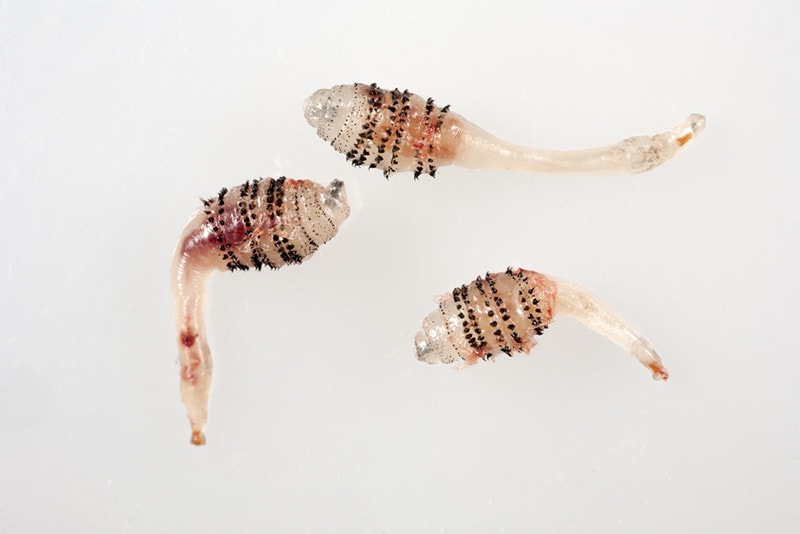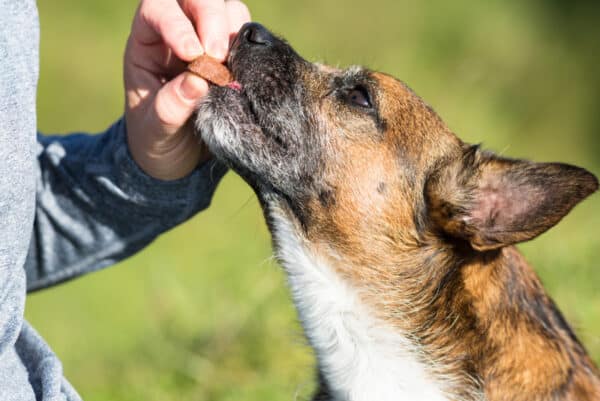In this article
View 4 More +You may recognize the word Cuterebra, or maybe you have seen interesting videos of them online. But do you know what a Cuterebra is? What exactly are you looking at when you see a veterinarian pull these out of a poor animal’s skin? Cuterebra are insects that can infect dogs. Continue reading to find out more about what a Cuterebra is, what causes it, and what to look for to know if your dog is affected.

What is a Cuterebra?
Cuterebra is the name of a genus of North American bot flies. These flies are not biting flies, but they lay eggs that then hatch when an animal, such as your dog, comes near them. The heat of the mammal’s body causes the eggs to hatch upon contact. The larvae are then what you’d see when they are pulled from the tissues of your pet.
These flies tend to be species-specific, which means that they will only continue their life cycle on or within certain animals. Other animals that can be affected are horses, cattle, and sheep. There aren’t flies specific to dogs. Rather, the rodent or rabbit fly will typically affect our dogs and cats.

What Are the Signs of a Cuterebra?
Any dog can become infected with a Cuterebra. However, it’s most common in dogs who live outdoors or are outdoor working dogs. We can see them occur in dogs who may work on a farm, are herding dogs, or hunting dogs. If your dog is curious and likes to sniff and get into everything in nature, no matter their breed or job, they may be susceptible to bot fly infestation.
At first, you may notice a red swelling on your dog’s skin. Sometimes, there is a purulent discharge (pus) from the site, and at first glance, you may think it’s an abscess. However, on closer inspection, you’ll notice that there is a small opening within the wound. This opening is the breathing hole for the botfly larvae and is essential for their survival.
Rarely, though not unheard of, you may also notice the tiny white Cuterebra peeking in and out of the breathing hole. Often, they will retreat into the site when they’re being looked at. However, if your dog is just lying there calmly, you may notice movement from the breathing hole.

What Are the Causes of Cuterebra in Dogs?
Bot fly females do not bite animals but lay their eggs in or around animals’ nests, burrows, or common living areas. Commonly, this occurs in/around the living spaces of rabbits and other rodents. Dogs, being the curious creatures they are, may be near these areas, sniffing, chasing the animals, or wanting to eat the rabbit or rodent feces. As the unknowing dog is in these areas, the eggs may hatch, and the resulting larvae may attach to the dog.
The life cycle stage after the egg is larvae. Once the egg hatches, the larvae may gain access to the inside of the dog’s body. This occurs through open wounds or through the mouth or nose as the dog is licking or grooming. These larvae will then migrate through the dog’s tissues. The larvae continue to develop and grow, breathing through a small opening in the dog’s skin and tissue.
While most bot flies are species-specific, the Cuterebra that affect dogs are most commonly of the rabbit and rodent species. They tend to be less picky about the species they infect, thus commonly infesting dogs and cats.

How Do I Care for a Dog With Cuterebra?
You should seek veterinary care if you suspect your dog may have a Cuterebra. Oftentimes, these warble sites are infected, swollen, and painful for your pet. Your veterinarian will prepare the site and carefully extract the Cuterebra (hopefully) in one piece. If you attempt to do this at home, you risk hurting your dog further. Some dogs may suffer an anaphylactic reaction as the warble is extracted. Anaphylaxis is a medical emergency; if it occurs, you’d rather your dog already be at the hospital.
In addition, if the warble is not removed in one piece, the remaining pieces can cause persistent infection, wounds, and pain. Your veterinarian will know if the entire warble has been removed and then check your dog for other sites you may have not seen.
Keep your dog from licking the suspected Cuterebra site by placing an e-collar or a t-shirt on them, and make an appointment with your veterinarian as soon as possible. Once at the veterinarian’s office, the Cuterebra will be removed, the wound cleaned, and your dog will likely placed on antibiotics and potentially pain medications. Your veterinarian will want to prevent your dog from licking the wound while it heals.
We recommend you consult a veterinarian for the best advice on which would be the best treatment for your pup.
If you need to speak with a vet but can't get to one, head over to PangoVet. It's our online service where you can talk to a vet online and get the advice you need for your dog — all at an affordable price!

Frequently Asked Questions (FAQs)
Will My Dog Die if Infected With a Cuterebra?
Most likely not. However, that doesn’t mean infestation is without risk. Your veterinarian must remove the warble in one complete piece, as crushing or breaking the warble apart can cause a serious allergic reaction. Also, the warble sites can become infected. Any infection will worsen if not cleaned and treated with appropriate antibiotics.

Can You Prevent Cuterebra Infection?
If your dog is at high risk—such as hunting, herding, or working dogs that live outside—we recommend speaking with your veterinarian about good flea, tick, and heartworm prevention. Many of these won’t deter flies, but they will help prevent other types of disease. Regular grooming, bathing, and monitoring of your dog’s skin may alert you to infestation early, but there is no good prevention for bot flies that is foolproof.

Conclusion
Cuterebra refers to the larval stage of the bot fly that can become stuck within the subcutaneous tissues of your dog. Removal is necessary to stop the life cycle, and the wound should be cleaned and treated with antibiotics. Treatment at home is not recommended, as crushing or breaking the warble may trigger a severe anaphylactic reaction in your dog. If your dog is always outside and you notice a wound you suspect may be a Cuterebra, contact your veterinarian for removal and care.
Featured Image Credit: AlessandraRC, Shutterstock


















